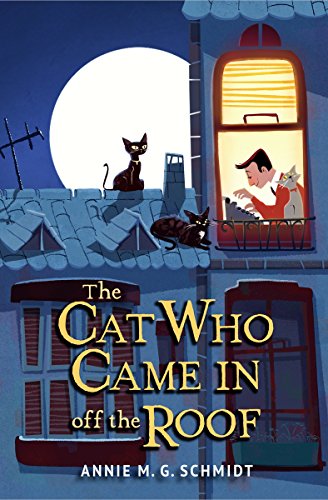
![]() The Cat Who Came In off the Roof by Annie M.G. Schmidt
The Cat Who Came In off the Roof by Annie M.G. Schmidt
Annie M.G. Schmidt, who died in 1995, was a beloved and well-respected author in the Netherlands, her native land. In 1988 she won the Hans Christian Anderson Award, the most distinguished international award in children’s literature, which is granted to authors and illustrators whose body of work has made a lasting contribution to children’s literature. Unfortunately, until now Schmidt’s work has not been published in the English language, so she is not well known in the U.S. That may change with the 2016 publication of her 1970 book, The Cat Who Came In off the Roof (Dutch title: “Minoes”), recently translated by David Colmer.
Tibble, a painfully shy reporter, is on the verge of losing his job with the Killenthorn Courier newspaper: his editor is tired of his articles about cats (“there’s never any news in them!”). The problem is that Tibble is too introverted to approach and talk to people and find out actual news in his town. On his way home he helps an attractive young redheaded woman who has been treed by a furiously barking German Shepherd. When he finds her later that evening rummaging for food in his garbage bin, soaked with the rain and stuffing a large fish skeleton into her mouth, he feels sorry for her and invites her into his home to dry off and share a meal.
This mysterious young lady, who introduces herself as Miss Minou, tells Tibble that she can talk to cats ― because she was once a cat herself! Tibble considers her “totally bonkers,” but he has to admit she has an unusual ability to communicate with his cat Fluff. So he lets her stay the night, curled up in a large box lined with fresh newspaper. On her way to bed, Minou says that another cat, Cross-Eyed Simon, told her that his owner, a schoolteacher, is depressed because no one in town has remembered his twenty-fifth anniversary as head teacher at the local school.
And suddenly Tibble has his first legitimate news story. His editor is delighted, and Minou develops an awesome ability to glean all the latest news from the local population of cats, who watch what their owners do and say… although some cats are more helpful than others.
“Guy Fawkes tried to blow up the Houses of Parliament,” the School Cat said. “Make sure it’s in tomorrow’s paper.”
“Thanks,” said Minou. He’d been sitting in on the history lesson again.
So Minou stays with Tibble and feeds him news scoops while he feeds her fish. This arrangement works out well for everyone involved, although Tibble has some trouble with trying to break Minou of overly cattish habits like rubbing up against people and stalking birds and mice. Minou herself is torn: she can’t decide whether she wants to remain a human or ― assuming she ever gets the chance ― go back to being a cat. But when the local cats find out that Mr. Ellmore, the president of the local Animal Lovers’ Association, is not only cruel to animals (when no one else is looking, of course) but is committing criminal acts, it will take the combined efforts of cats and humans to try to bring his nefarious deeds to light.
The Cat Who Came In off the Roof has an original, quirky flavor that may derive from its European origin and setting. The various cat characters are particularly appealing and memorable, including the Tatter Cat, a stray who views humans with deep distrust but is Minou’s primary source for interesting news, and the misguided School Cat (“I’ve got some news… Henry the Eighth got divorced.”). Minou’s Aunt Sooty turns up occasionally to offer her suggestions and advice:
Wash yourself with spit. Lick yourself. That is the beginning and end of all wisdom.
In its original Dutch form, The Cat Who Came In off the Roof was the 1971 winner of Dutch Zilveren Griffel (Silver Pencil) literary award for children’s literature. It was the basis for the popular 2001 Dutch film Minoes, which was later dubbed and released in an English version under the titles Miss Minoes and Undercover Kitty.
This charming fantasy novel is written at a middle grade level, but the humor and deft characterization of the local cat population will endear it to adults as well as children. It’s a simple but heartwarming tale, and a must-read for anyone who loves cats!



I just sent the link to my friend who is a cat person, and the children’s book specialist for our local bookstore.I think this is her kind of thing!
I do wonder if the title is going to confuse mystery readers, because of the old “Cat Who…” series.
I’m going to recommend this to some cat-lovers right now — thanks, Tadiana!